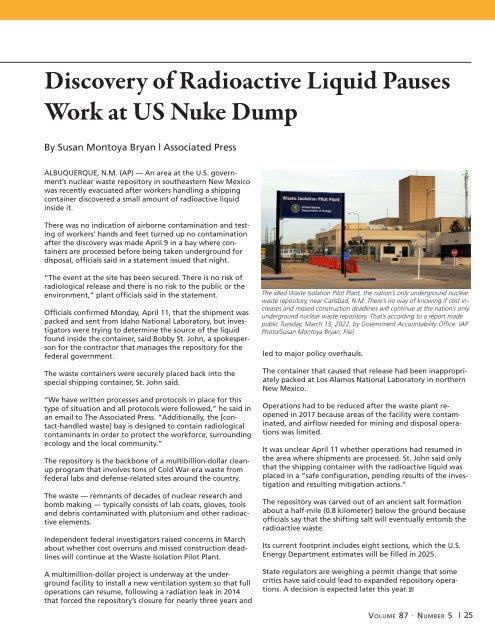CEAC-2022-05-May
Create successful ePaper yourself
Turn your PDF publications into a flip-book with our unique Google optimized e-Paper software.
Discovery of Radioactive Liquid Pauses<br />
Work at US Nuke Dump<br />
By Susan Montoya Bryan | Associated Press<br />
ALBUQUERQUE, N.M. (AP) — An area at the U.S. government’s<br />
nuclear waste repository in southeastern New Mexico<br />
was recently evacuated after workers handling a shipping<br />
container discovered a small amount of radioactive liquid<br />
inside it.<br />
There was no indication of airborne contamination and testing<br />
of workers’ hands and feet turned up no contamination<br />
after the discovery was made April 9 in a bay where containers<br />
are processed before being taken underground for<br />
disposal, officials said in a statement issued that night.<br />
“The event at the site has been secured. There is no risk of<br />
radiological release and there is no risk to the public or the<br />
environment,” plant officials said in the statement.<br />
Officials confirmed Monday, April 11, that the shipment was<br />
packed and sent from Idaho National Laboratory, but investigators<br />
were trying to determine the source of the liquid<br />
found inside the container, said Bobby St. John, a spokesperson<br />
for the contractor that manages the repository for the<br />
federal government.<br />
The waste containers were securely placed back into the<br />
special shipping container, St. John said.<br />
“We have written processes and protocols in place for this<br />
type of situation and all protocols were followed,” he said in<br />
an email to The Associated Press. “Additionally, the [contact-handled<br />
waste] bay is designed to contain radiological<br />
contaminants in order to protect the workforce, surrounding<br />
ecology and the local community.”<br />
The repository is the backbone of a multibillion-dollar cleanup<br />
program that involves tons of Cold War-era waste from<br />
federal labs and defense-related sites around the country.<br />
The waste — remnants of decades of nuclear research and<br />
bomb making — typically consists of lab coats, gloves, tools<br />
and debris contaminated with plutonium and other radioactive<br />
elements.<br />
Independent federal investigators raised concerns in March<br />
about whether cost overruns and missed construction deadlines<br />
will continue at the Waste Isolation Pilot Plant.<br />
A multimillion-dollar project is underway at the underground<br />
facility to install a new ventilation system so that full<br />
operations can resume, following a radiation leak in 2014<br />
that forced the repository’s closure for nearly three years and<br />
The idled Waste Isolation Pilot Plant, the nation’s only underground nuclear<br />
waste repository, near Carlsbad, N.M. There’s no way of knowing if cost increases<br />
and missed construction deadlines will continue at the nation’s only<br />
underground nuclear waste repository. That’s according to a report made<br />
public Tuesday, March 15, <strong>2022</strong>, by Government Accountability Office. (AP<br />
Photo/Susan Montoya Bryan, File)<br />
led to major policy overhauls.<br />
The container that caused that release had been inappropriately<br />
packed at Los Alamos National Laboratory in northern<br />
New Mexico.<br />
Operations had to be reduced after the waste plant reopened<br />
in 2017 because areas of the facility were contaminated,<br />
and airflow needed for mining and disposal operations<br />
was limited.<br />
It was unclear April 11 whether operations had resumed in<br />
the area where shipments are processed. St. John said only<br />
that the shipping container with the radioactive liquid was<br />
placed in a “safe configuration, pending results of the investigation<br />
and resulting mitigation actions.”<br />
The repository was carved out of an ancient salt formation<br />
about a half-mile (0.8 kilometer) below the ground because<br />
officials say that the shifting salt will eventually entomb the<br />
radioactive waste.<br />
Its current footprint includes eight sections, which the U.S.<br />
Energy Department estimates will be filled in 2025.<br />
State regulators are weighing a permit change that some<br />
critics have said could lead to expanded repository operations.<br />
A decision is expected later this year.<br />
Volume 87 · Number 5 | 25


















